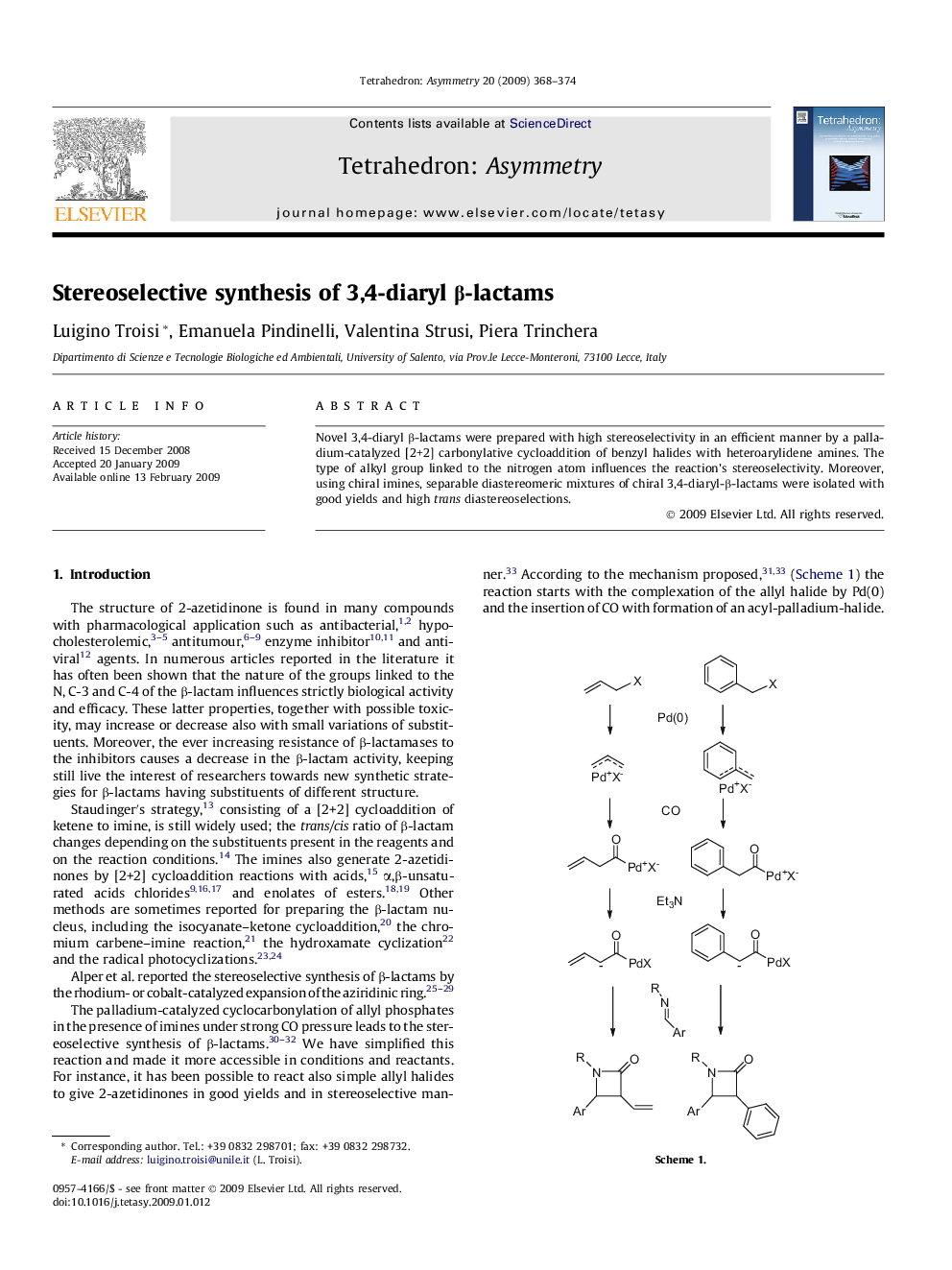| Article ID | Journal | Published Year | Pages | File Type |
|---|---|---|---|---|
| 1347477 | Tetrahedron: Asymmetry | 2009 | 7 Pages |
Novel 3,4-diaryl β-lactams were prepared with high stereoselectivity in an efficient manner by a palladium-catalyzed [2+2] carbonylative cycloaddition of benzyl halides with heteroarylidene amines. The type of alkyl group linked to the nitrogen atom influences the reaction’s stereoselectivity. Moreover, using chiral imines, separable diastereomeric mixtures of chiral 3,4-diaryl-β-lactams were isolated with good yields and high trans diastereoselections.
Graphical abstractFigure optionsDownload full-size imageDownload as PowerPoint slide
(−)-(3R,4S,1′R)-(trans)-3-Phenyl-1-(1-phenylethyl)-4-pyridin-2-ylazetidin-2-oneC22H20N2OEe = 100%[α]D30.6=-99.25 (c 0.008, CHCl3)Source of chirality: asymmetric inductionAbsolute configuration: (3R,4S,1′R)
(+)-(3S,4R,1′R)-(trans)-3-Phenyl-1-(1-phenylethyl)-4-pyridin-2-ylazetidin-2-oneC22H20N2OEe = 100%[α]D31.4=+113.9 (c 0.015, CHCl3)Source of chirality: asymmetric inductionAbsolute configuration: (3S,4R,1′R)
(−)-(3R,4S,1′R)-(trans)-3-Phenyl-1-(1-phenylethyl)-4-pyridin-4-ylazetidin-2-oneC22H20N2OEe = 100%[α]D28.2=-93.3 (c 0.01, CHCl3)Source of chirality: asymmetric inductionAbsolute configuration: (3R,4S,1′R)
(+)-(3S,4R,1′R)-(trans)-3-Phenyl-1-(1-phenylethyl)-4-pyridin-4-ylazetidin-2-oneC22H20N2OEe = 100%[α]D29.4=+103.3 (c 0.012, CHCl3)Source of chirality: asymmetric inductionAbsolute configuration: (3S,4R,1′R)
(−)-(3R,4S,1′R)-(trans)-3-Phenyl-1-(1-phenylethyl)-4-pyridin-3-ylazetidin-2-oneC22H20N2OEe = 100%[α]D27.2=-79.9 (c 0.012, CHCl3)Source of chirality: asymmetric inductionAbsolute configuration: (3R,4S,1′R)
(+)-(3S,4R,1′R)-(trans)- 3-Phenyl-1-(1-phenylethyl)-4-pyridin-3-ylazetidin-2-oneC22H20N2OEe = 100%[α]D28.2=+51.5 (c 0.010, CHCl3)Source of chirality: asymmetric inductionAbsolute configuration: (3S,4R,1′R)
(−)-(3R,4S,1′R)-(trans)-4-(4-Methylthiazol-2-yl)-3-phenyl-1-(1-phenylethyl)azetidin-2-oneC21H20N2OSEe = 100%[α]D23.0=-88.1 (c 0.010, CHCl3)Source of chirality: asymmetric inductionAbsolute configuration: (3R,4S,1′R)
(+)-(3S,4R,1′R)-(trans)-4-(4-Methylthiazol-2-yl)-3-phenyl-1-(1-phenylethyl)azetidin-2-oneC21H20N2OSEe = 100%[α]D23.0=+100.6 (c 0.012, CHCl3)Source of chirality: asymmetric inductionAbsolute configuration: (3S,4R,1′R)
(−)-(3R,4S,1′R)-(trans)-4-Benzothiazol-2-yl-3-phenyl-1-(1-phenylethyl)azetidin-2-oneC24H20N2OSEe = 100%[α]D28.0=-72.5 (c 0.015, CHCl3)Source of chirality: asymmetric inductionAbsolute configuration: (3R,4S,1′R)
(+)-(3S,4R,1′R)-(trans)-4-Benzothiazol-2-yl-3-phenyl-1-(1-phenylethyl)azetidin-2-oneC24H20N2OSEe = 100%[α]D31.0=+86.1 (c 0.013, CHCl3)Source of chirality: asymmetric inductionAbsolute configuration: (3S,4R,1′R)
(−)-(3R,4S,1′R)-(trans)- 3-(4-Methoxyphenyl)-1-(1-phenylethyl)-4-pyridin-2-ylazetidin-2-oneC23H22N2O2Ee = 100%[α]D24.9=-205.0 (c 0.012, CHCl3)Source of chirality: asymmetric inductionAbsolute configuration: (3R,4S,1′R)
(+)-(3S,4R,1′R)-(trans)- 3-(4-Methoxyphenyl)-1-(1-phenylethyl)-4-pyridin-2-ylazetidin-2-oneC23H22N2O2Ee = 100%[α]D25.7=+110.0 (c 0.012, CHCl3)Source of chirality: asymmetric inductionAbsolute configuration: (3S,4R,1′R)
